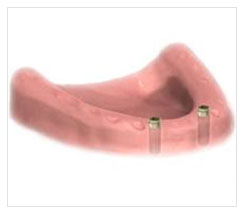
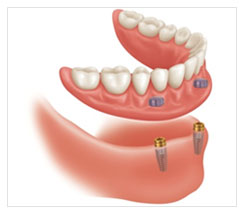
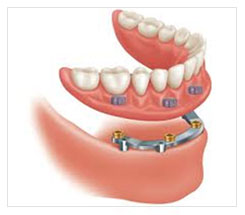
What Is It?
- An implant-supported denture is a type of overdenture that is supported by and attached to implants
- A regular denture rests on the gums, and is not supported by implants.
- An implant-supported denture is used when a person doesn't have any teeth in the jaw, but has enough bone in the jaw to support implants.
- An implant-supported denture has special attachments that snap onto attachments on the implants.
- Implant-supported dentures usually are made for the lower jaw because regular dentures tend to be less stable there.
- Usually, a regular denture made to fit an upper jaw is quite stable on its own and doesn't need the extra support offered by implants.
- However, you can receive an implant-supported denture in either the upper or lower jaw.
- You should remove an implant-supported denture daily to clean the denture and gum area.
- Just as with regular dentures, you should not sleep with the implant-supported dentures at night.
- Some people prefer to have fixed (permanent) crown and bridgework in their mouths that can't be removed.
- Your dentist will consider your particular needs and preferences when suggesting fixed or removable options.
How Does It Work?
There are two types of implant-supported dentures: bar-retained and ball-retained.
In both cases, the denture will be made of an acrylic base that will look like gums.Porcelain or acrylic teeth that look like natural teeth are attached to the base.
Both types of dentures need at least two implants for support.
Bar-retained dentures - A thin metal bar that follows the curve of your jaw is attached to two to five implants that have been placed in your jawbone. Clips or other types of attachments are fitted to the bar, the denture or both. The denture fits over the bar and is securely clipped into place by the attachments.
Ball-retained dentures (stud-attachment
dentures) - Each implant in the jawbone holds a
metal attachment that fits into another attachment on
the denture. In most cases, the attachments on the
implants are ball-shaped ("male" attachments), and they
fit into sockets ("female" attachments) on the denture.
In some cases, the denture holds the male attachments
and the implants hold the female ones.
The Implant Process
- The implants usually are placed in the jawbone at the front of your mouth because there tends to be more bone in the front of the jaw than in the back.
- This usually is true even if teeth have been missing for some time.
- Once you lose teeth, you begin to lose bone in the area.
- Also, the front jaw doesn't have many nerves or other structures that could interfere with the placement of implants.
- Two surgeries usually are needed. The first one places the implants in the jawbone under your gums.
- The second surgery exposes the tops of the implants.
- A one-stage procedure is now used sometimes.
- In this procedure, your dentist can place the implants and the supporting bar in one step.
- The success rate of this procedure is high.
Initial consultation
During the exam, the dentist will review your medical and dental histories, take X-rays and create impressions of your teeth and gums so that models can be made. In some cases, the dentist may order a computed tomography (CT) scan of your mouth. This shows where your sinuses (located above your upper teeth) and nerves are. It allows the dentist to make sure they will not be affected by the implant placement. A CT scan also may be done to see how much bone is available and to determine the best locations for the implants. If you are not already wearing a complete denture to replace your missing teeth, your dentist will make you one. You will use this temporary denture until the implant-supported denture is placed. By making this temporary denture, your dentist is able to determine the best position for the teeth in the final denture. The temporary denture also can be used as a backup if something happens to the final implant-supported denture. The temporary denture can also be used as the final denture to reduce overall costs. Attachments will need to be added so it can fit securely to the implants. Once the temporary denture is finished, the surgeon will use a copy of it as a guide to help place the implants in the proper positions.Holes will be drilled in the copy of the denture so
that the surgeon can see where the implants should be
placed.
First surgery
 The
first surgery involves placing the implants in the
jawbone. During the first surgery, an incision is made
in the gum where the implant will be placed. A hole is
drilled in the bone, the implant is placed into the
hole, and the incision is stitched closed. After this
surgery, you should avoid putting pressure on the
implants. The temporary denture can be made so that
direct pressure is placed on other areas, not on the
implants. It may also be given a soft reline (new lining
next to your gums) to help to reduce the pressure on
your gums. After the first surgery, the dentist will
wait till the bone and the implants integrate (attach
and fuse).
The
first surgery involves placing the implants in the
jawbone. During the first surgery, an incision is made
in the gum where the implant will be placed. A hole is
drilled in the bone, the implant is placed into the
hole, and the incision is stitched closed. After this
surgery, you should avoid putting pressure on the
implants. The temporary denture can be made so that
direct pressure is placed on other areas, not on the
implants. It may also be given a soft reline (new lining
next to your gums) to help to reduce the pressure on
your gums. After the first surgery, the dentist will
wait till the bone and the implants integrate (attach
and fuse).
Second visit
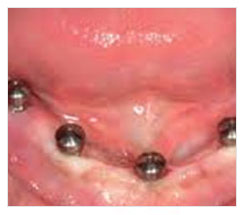 Once
the implants have become fused with the bone, the second
visit can be scheduled. Your dentist will confirm
whether the implant is ready by taking an X-ray. A
healing cap (collar) is placed on the head of each
implant after it is exposed. This guides the gum tissue
to heal correctly. The collar is a round piece of metal
that holds the gums away from the head of the implant.
After about two weeks, the healing caps will be replaced
with regular abutments. Your gums should now be healed
enough for your dentist to make an impression of your
gum tissue and abutments. The impression is used to make
a working model of your abutments and jaw. This model is
used to make the denture framework and teeth.
Once
the implants have become fused with the bone, the second
visit can be scheduled. Your dentist will confirm
whether the implant is ready by taking an X-ray. A
healing cap (collar) is placed on the head of each
implant after it is exposed. This guides the gum tissue
to heal correctly. The collar is a round piece of metal
that holds the gums away from the head of the implant.
After about two weeks, the healing caps will be replaced
with regular abutments. Your gums should now be healed
enough for your dentist to make an impression of your
gum tissue and abutments. The impression is used to make
a working model of your abutments and jaw. This model is
used to make the denture framework and teeth.
Denture Try-In and Insertion
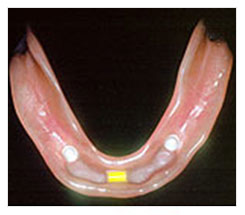 At
this point, the metal bar is placed on the abutments.
You will have the first try-in of your new denture
framework to see if it fits properly. Once the metal bar
and the denture framework have been fitted together
properly, the teeth are temporarily placed on the
framework in wax. The whole denture is then tried in
your mouth. If everything works well, the teeth are
secured in the denture framework permanently. The bar or
ball attachments also will be secured. You will have to
return to your dentist for another visit to have the
completed denture inserted. When the denture is
inserted, the denture is clipped onto the bar or snapped
onto the ball attachments. At this point, your temporary
denture will be given a new reline. This will allow it
to be used as a backup denture in case you lose or break
your new overdenture. If you are using the "temporary"
denture as a permanent denture, the bar or ball
attachments are placed in that denture.
At
this point, the metal bar is placed on the abutments.
You will have the first try-in of your new denture
framework to see if it fits properly. Once the metal bar
and the denture framework have been fitted together
properly, the teeth are temporarily placed on the
framework in wax. The whole denture is then tried in
your mouth. If everything works well, the teeth are
secured in the denture framework permanently. The bar or
ball attachments also will be secured. You will have to
return to your dentist for another visit to have the
completed denture inserted. When the denture is
inserted, the denture is clipped onto the bar or snapped
onto the ball attachments. At this point, your temporary
denture will be given a new reline. This will allow it
to be used as a backup denture in case you lose or break
your new overdenture. If you are using the "temporary"
denture as a permanent denture, the bar or ball
attachments are placed in that denture.
Caring for Your Implant-Supported Denture
You will need to remove the denture at at night and
for cleaning. You also should carefully clean around the
attachments.
What Will X-Rays Show?
An X-ray will show the implants in the jaw and any
attachments to them x-rays help the dentist to see that
the implants, abutments and attachments are in the right
places.
 What
Can You Expect From Your Implant-Supported Denture?
What
Can You Expect From Your Implant-Supported Denture?
Your implant-supported denture will be more stable than a regular denture. You will find it easier to speak and you won't have to worry about the denture becoming loose or falling out of your mouth.
You generally will be able to eat foods you could not eat before. If you have an implant-supported denture in your upper jaw, it can be made to cover less of your palate (roof of your mouth) than a regular denture.
That's because the implants are holding it in place instead of the suction created between the full denture and your palate.
Dental Care
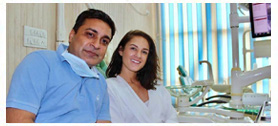
Regular dental care is an important part of oral health. Having healthy teeth and gums isn't a given, though.

Dental Tourism
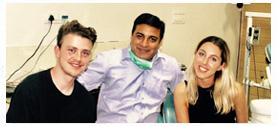
Our dental tourism packages, transport you to the world of royalty in all its regal splendor. An experience of a lifetime awaits you...

Brushing your teeth

Your teeth are meant to last a lifetime! Tooth decay, or cavities, and periodontal disease, also known as gum disease, can ..

Oral Health Problems

If one or more of your teeth are missing, there are a number of ways to replace them. An alternative to bridges, partials or complete...

Patient Gallery
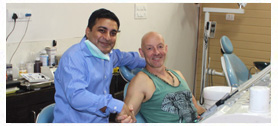
Here's just a few "before-and-after" photos of some of our most common procedures. Come in and see how we can enhance your smile.


